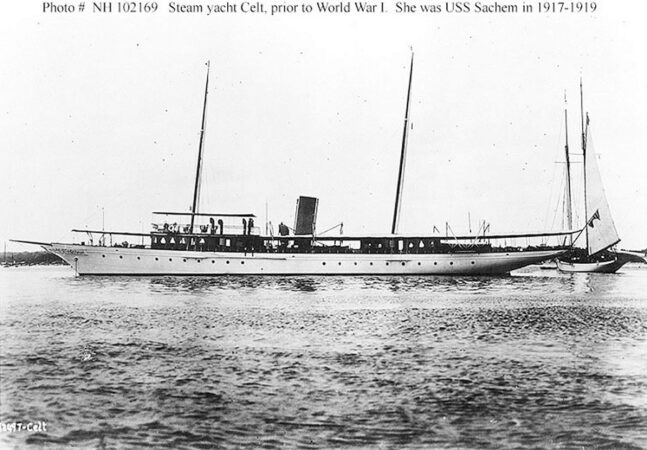Editor’s note: For a full and very detailed illustrated history of the Sachem, and to support its preservation and restoration, visit the-sachem-project.org.
By John R. Barrows
The Sachem is a storied vessel. Launched in 1901 as a luxury steam yacht named Celt, built in Wilmington, Del., the ship was commissioned by New York millionaire John Rogers Maxwell, who cruised the waters around Long Island. He used the Celt to view his racing yachts compete in sailboat regattas. After a decade, following Maxwell’s passing, the Celt was sold and renamed Sachem, where it continued to serve as a personal luxury craft.
At the onset of World War I, the U.S. Navy began to requisition private boats and yachts such as Sachem, fast and maneuverable, to serve in the defense against German submarines. The Sachem became the USS Sachem (SP-92), the “SP” standing for “Section Patrol.” The ship was completely refitted for warfare, with depth charges, various guns, and entered military service on August 19, 1917, patrolling the East Coast for U-boats before being handed over to become Thomas Edison’s floating laboratory, based out of Sandy Hook. After the war, the ship was returned to its owners. After changing hands, the ship saw time as a rumrunner during Prohibition, and then as a luxury charter deep-sea fishing boat, which proved to be a prosperous period.
After the attack on Pearl Harbor, the Navy again requisitioned the Sachem, and again refitted it for warfare, now renaming it the USS Phenakite (PYc-25); “PY” was the designation for patrol boats; Phenakite is the name of a rare gemstone. The USS Phenakite served on submarine patrol duty, but just as in the first world war, saw no enemy action.
After the war it was decommissioned, and offered for scrap. A former owner re-purchased it, and re-named it Sachem; but, unable to afford the necessary repairs to enable charter fishing, the boat was sold to the company that would become known as the Circle Line, providing water tours of Manhattan and New York Harbor. The Sachem was renamed Sightseer, and later, in the 1950’s, Circle Line Sightseer, and eventually, Circle Line V.
In 1977, after 31 years, it was removed from the Circle Line fleet. It was stripped of usable parts, donated to the Sea Scouts, and allowed to deteriorate. In 1986, the hulk was hauled out of the muck of the Hudson River with the help of bulldozers, and restored to seaworthiness. The ship’s new owner wanted to bring it to his hometown of Cincinnati, Ohio, and eventually succeeded in coaxing the aging, decrepit craft up the Hudson River, through the Erie Canal, across the Great Lakes, down the Chicago River to the Mississippi, into the Ohio River at Cairo, and thence into Taylor Creek in Kentucky, near the owner’s home. The voyage took 40 days.
But this was the end of the line. The ships new owner lacked funds to complete restorations, and the Sachem was abandoned, rusting in the muck and weeds, completely forgotten. The owner moved to Mexico, and eventually sold his land to neighbors. On October 31, 2009, kayakers came across the listing hulk, identified it as the former Circle Line V, and brought attention to it. Various community members have formed a group dedicated to preserving and restoring the ship, after 116 years, but as of now, it still sits aground in its Kentucky riverbed.
Sources:
Morris, Edmund. (2019). Edison. Random House, New York, N.Y.
Baldwin, Neil. (1995). Edison: Inventing the Century. Hyperion, New York, N.Y.
Edison May Quit Naval Board. (1917). The Daily Record (Long Branch), March 7, 1917, P. 1.
Thomas A. Edison Here. (1917). The Daily Register (Red Bank), July 18, 1917, P. 1.
https://www.the-sachem-project.org/
Featured image: USS Phenakite 1942-1945. Official U.S. Navy photo NH 102169, Public Domain.


The boat is in Kentucky not Ohio! The owner lived in Kentucky not Ohio!
Thanks…that’s a bad miss on my part and a good catch, fixed now.